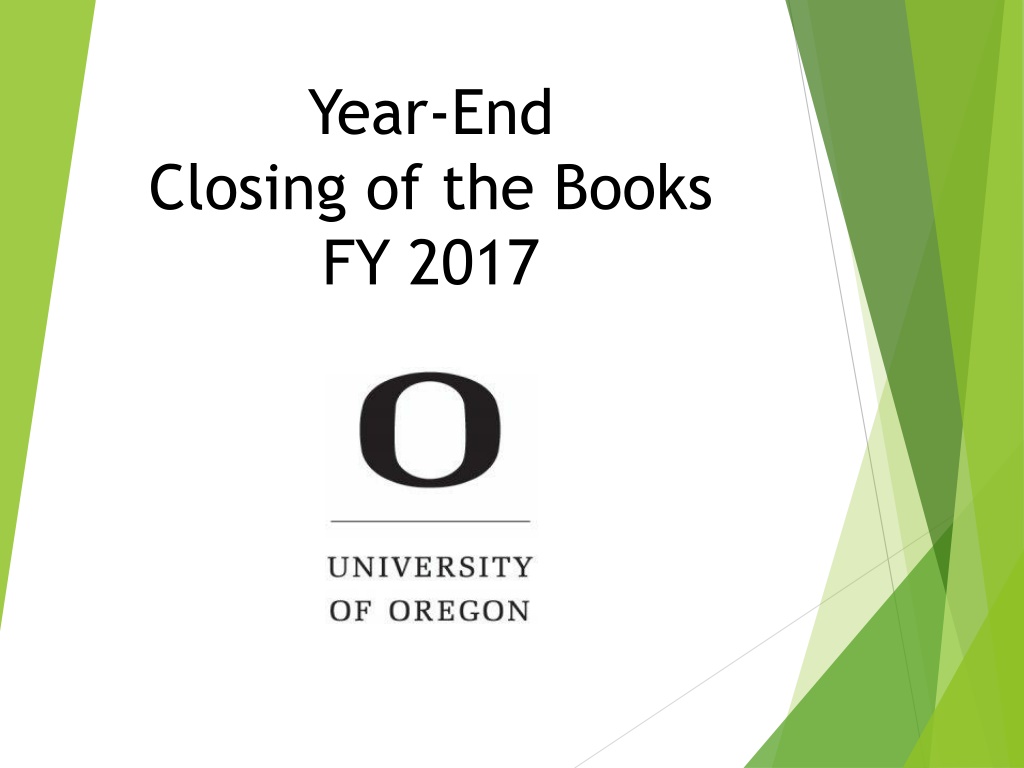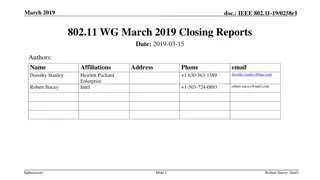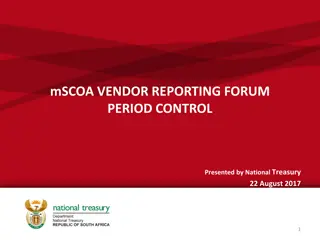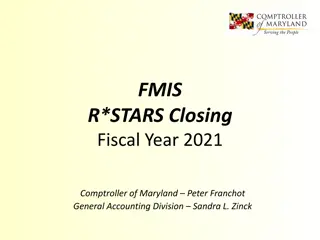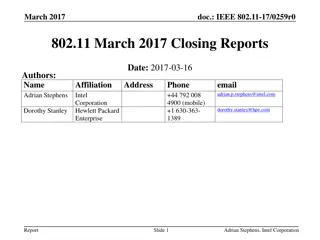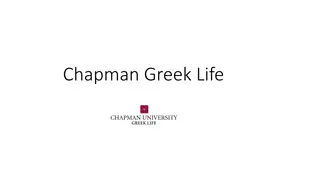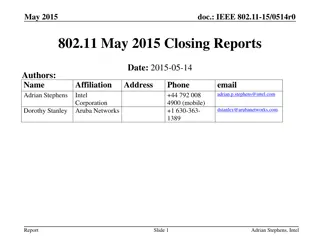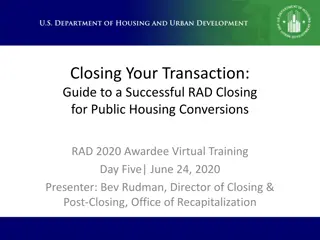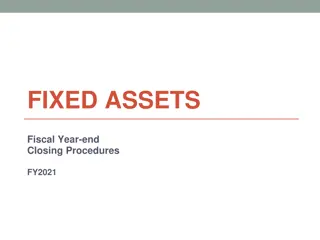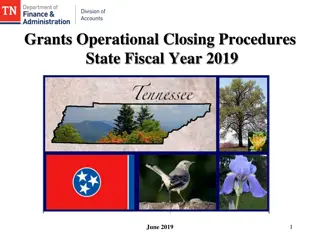Year-End Closing of the Books FY 2017 Overview
In the process of year-end closing for FY 2017, transactions and accruals between July 1, 2016, and June 30, 2017 are recorded to meet GAAP requirements. This includes monitoring, budgeting, system audits, and issuing audited financial statements for stakeholders. Departments review, post corrections, and issue financial statements before closing the fiscal period.
Download Presentation

Please find below an Image/Link to download the presentation.
The content on the website is provided AS IS for your information and personal use only. It may not be sold, licensed, or shared on other websites without obtaining consent from the author.If you encounter any issues during the download, it is possible that the publisher has removed the file from their server.
You are allowed to download the files provided on this website for personal or commercial use, subject to the condition that they are used lawfully. All files are the property of their respective owners.
The content on the website is provided AS IS for your information and personal use only. It may not be sold, licensed, or shared on other websites without obtaining consent from the author.
E N D
Presentation Transcript
Year-End Closing of the Books FY 2017
Overview of Closing Why do we close? GAAP Generally Accepted Accounting Principles End of the business cycle: State sessions end in June UO activity begins with summer session (excluding Law) Federal (GASB) & State requirements UO mandated deadlines in order to meet required State deadlines Snapshot in time YTD activity (FWIBUDG) and year-end balances (FGITBAL) are used tomonitor, project, budget, evaluate performance, perform system audits, analyze anomalies, audit, compare and contrast with other years/funds/institutions etc
Overview of Closing Annual reporting internal & external UO issues annual audited financial statements Used by stakeholders such as general public, federal agencies, HECC, federal F&A rate setters, accrediting agencies, NCAA, creditors and bond services, etc Rolled into State of Oregon financial statements Auditors internal & external Test for accuracy, consistency, completeness, cutoff, & reliability of systems including our policies & procedures Help us establish best practices Includes: UO Internal Audit, DHHS, Naval Research, NCAA, Moss Adams (financial statement & Single Audit), Secretary of State, etc
Overview of Closing Recording activity that takes place between: July 1, 2016 and June 30, 2017 Transactions must be recorded in the fiscal year that the event takes place, regardless of when budget or cash is available Includes accruals posted by July 18, 2017 Applies to all funds regardless of the source
Overview of Closing Fiscal period 12 Record June and remaining FY17 activity Fiscal period 14 (opens after closing period 12) Review and post necessary corrections/accruals Departments have first week BAO/BRP/SPS have additional time BAO CAFAR/Accounting team Extracts data for reports Analyzes transactions for correctness Records system-wide accruals Accumulates and records remaining FY17 transactions Issues audited financial statements Close fiscal period 14
Balance Sheet Account Codes (FGITBAL General Ledger) A = Assets B = Liabilities C = Control Accounts (Income Statement Totals) D = Fund Balance E = Fund Additions F = Fund Deletions When FP12 is closed and FP14 is opened, income/expense account balances from FY17 FP12 are closed into FY18 fund balance.
Income Statement/Balance Sheet FWIBUDG Income Statement Balance Sheet 0XXXX FGITBAL Revenue C0010 Labor General Expense Transfers 9XXXX 1XXXX 2XXXX-8XXXX C2010 C1010 C5010 Fund Bal D0010
FY18 Beginning Balances Before period 14 is opened, FY18 balances only include FY18 transactions
FY18 Beginning Balances When period 14 is opened, FY17 period 12 ending balances are posted as FY18 beginning balances Recorded in period 00 Document type YEOB, numbered GLRL17XX Then, each entry posted to FY17 during period 14 has a mirror entry in FY18 period 00 Identifiable by its June transaction date
Subsidiary Ledgers Provide a greater amount of detailed information for general ledger account balances FIS Examples Student A/R, Grants Billing Module, Fixed Asset System, Accounts Payable Complimentary (shadow) systems are often used by departments as subsidiary ledgers (examples QuickBooks, Excel, Access) Subsidiary ledgers must be reconciled to Banner FIS The FIS general ledger is the official source of financial information for the UO
Subsidiary Ledgers General ledger account codes require supporting detail schedules reconciled to Banner FIS. Commonly used accounts include: Account Code Account Code Title Account Code Account Code Title A3103 Misc Accounts Receivable B0190 Received Items Payable A3106 Sundry Receivable B5120 Prepaid Tuition & Fees A3702 AR from Affiliated Foundation B5802 Unearned Revenue A4002 Organized Storeroom Inventories B5817 Unredeemed Gift Cards/Certificates A5019 Prepaid Services & Supplies B5801 Undistributed Revenue A5020 Prepaid Travel A5021 Prepaid Subscriptions/Memberships A5022 Prepaid Capital Assets A5023 Prepaid Software Expenditures A5030 Prepaid Miscellaneous Expense
Non-SIS Accounts Receivable Each department must submit a detail and aging report of their non-SIS accounts by July 19th http://pages.uoregon.edu/baoforms/bao_drupal_6/ sites/ba.uoregon.edu/files/forms/yearendar.xlsx These reports must be reconciled to Banner as of fiscal period 14 (generally use FGITBAL) Includes all receivables from entities that are external to UO
Non-SIS Accounts Receivable Account Code A3101 A3103 A3106 A3109 A3110 A3130 A3131 A3132 A3133 A3134 A3135 A3702 Account Code Title Misc Advances Receivable-Non SIS Misc A/R Sundry Receivable NIBL-Non SIS Travel Advance Receivable Non-SIS Restoration Fund Receivable Catering Accounts Receivable Setup/Tech Accounts Receivable Child Care Accounts Receivable USDA Accounts Receivable Season Ticket Accounts Receivable AR from Affiliated Foundation
Non-SIS Accounts Receivable University of Oregon Non-Student Accounts Receivable Aging As of June 30, 2017 Department: Fund: Acct Code: Prepared by: Approved by: Date Submitted: Due From Description of Charge Current Year FY17 1-2 Years FY16 2-3 Years FY15 3-4 Years FY14 4-5 Years FY13 5 Years or Older Total* 0 0 0 0 0 0 0 0 0 0 0 0 0 0 0 Total 0 0 0 0 0 0 0 * Totals must reconcile to the General Ledger by fund and account Banner FGITBAL Balance: 0 0 0 0 0 0 List indexes associated with this reconciliation:
Cut-Off Guidelines & Accruals According to GAAP, accrual accounting requires: Expenses to be recorded in the fiscal year and period in which the goods or services are received, regardless of when payment is made. Payables Prepaid Expense Revenue to be recorded in the fiscal year and period in which the goods or services are provided, regardless of when payment is received. Accounts Receivable Unearned Revenue
Unearned and Undistributed Revenue Unearned Revenue - Payments received for goods or services which have not yet been provided. Revenue applicable to future fiscal years that is received prior to June 30, 2017 should be coded to unearned revenue account code (B5802). Post a reversing journal voucher with a transaction date in the future fiscal year and period that the goods or services will be provided. This journal voucher may be processed at the same time, if the future period is open. Undistributed Revenue - Revenue earned for goods or services and not yet distributed. Undistributed revenue (B5801) should be cleared to zero by year-end close.
Unearned Revenue Accruals To deposit payment through TWADEPO when it is received: Debit (CASH, CHEK, CARD, or BANK depending how revenue was received) Credit (MISC) Department Index Unearned Revenue Account Code (B5XXX) To remove the unearned revenue and recognize revenue in the future year: Debit Credit Department Index Department Index Unearned Revenue Account Code (B5XXX) Revenue Account Code
Unearned & Undistributed Revenue Account Codes Account Code Account Code Title Unearned Revenue B5120 Prepaid Tuition & Fees B5802 Unearned Revenue B5816 Athletics Prepaid Revenue B5817 Unredeemed Gift Cards/Certificates Undistributed Revenue B5801 Undistributed Revenue
Payable Accruals For goods or services received by June 30th for which vendor invoices have not been received as of July 18th, fill out an AP Report and forward it to BAO Financial Services along with backup. http://ba.uoregon.edu/sites/ba/files/forms/yearendap.pdf
Payable Accruals For invoices paid with an FY18 transaction date for goods or services that were provided by June 30th, input a JV to record the payable in FY17. To record the payable and expense in FY17: Debit Department Index Expense Account Code Credit Department Index Received Items Payable B0190 To reverse the accrual in FY18: Debit Department Index Received Items Payable B0190 Credit Department Index Expense Account Code * After July 18th (dept. lockout), please provide the information to BAO Financial Services
Prepaid Expense Accruals Prepaid Expense: Expenses for future fiscal years that are paid prior to June 30, 2017 should be coded to a prepaid expense account code. Post a reversing journal voucher with a transaction date in the future fiscal year and period that the goods or services will be received. This journal voucher may be processed at the same time, if the future period is open. For amounts posted as expense in FY17, that should be prepaid expenses for future years: Debit Department Index Prepaid Expense (A5013 A5030) Credit Department Index Expense Account Code To remove the prepaid and recognize the expense in the future year: Debit Department Index Expense Account Code Credit Department Index Prepaid Expense (A5013 A5030) *** Tax reportable expenses must first be coded to an expense account code when processing an invoice.
Common Prepaid Expense Account Codes Account Code Account Code Title A5019 Prepaid Services & Supplies A5020 Prepaid Travel A5021 Prepaid Subscriptions/Memberships A5022 Prepaid Capital Assets A5023 Prepaid Software Expenditures A5030 Prepaid Miscellaneous Expense
Departmental Deposits in Transit Please record a departmental deposit in transit for payments you have received in June, but cannot deposit with the Cashiers Office by June 30, 2017. To record the deposit in transit by JV with a June 2017 date: Debit Dept. Index A0951 Cash-Department Deposit In Transit Credit Dept. Index Revenue, Unearned Revenue, Accounts Receivable, etc. To make the physical deposit with UO Cashiers using Banner form TWADEPO as soon as possible after June 30, 2017: Debit CASH, CHEK, or CARD depending on how the payment was received Credit Dept. Index A0951 Cash-Department Deposit In Transit
Dates to Remember: June 8 June regular payroll deadline June 16 Contact BAO for help accruing department non-student accounts receivable June 28 Last day to submit wire transfer to AP by 10:00am June 30 Last day to submit student receivables June 30 Last day to deposit cash by 3:00pm June 30 Goods and services must be received by this date to pay with FY17 funds **(Items input in July require a 30-JUN-2017 transaction date)**
Dates to Remember: July 10 Last day to submit upload JVs for period 12 (Z documents through AppWorx) July 11Last day to liquidate encumbrances that shouldn t roll to FY18 July 11 Last day to submit budget changes for period 12 July 11 Last day to input an invoice for period 12 July 11 Last day to input JVs for period 12 July 11 Period 12 Close (5:00pm) July 12 Period 12 reports are available **(Items input in July require a 30-JUN-2017 transaction date)**
Dates to Remember: July 18 Last day to input JVs for period 14 July 18 Last day to input budget changes for period 14 July 18 Last day to input an invoice for period 14 July 18 Departmental lock-out (5:00pm) July 19 Detail and aging reports due for all non-SIS accounts receivable For assistance with FY17 transactions after the lock-out, contact BAO Accounting. **(Items input in July require a 30-JUN-2017 transaction date)**
Dating FIS Documents After June 30th, any document input for FY17 must have the transaction date changed to This includes: Budget changes Invoices JVs 30-JUN-2017 Travel reimbursements
Encumbrances All open encumbrances (except zero balance items) will be rolled into FY18 Banner FIS operating ledger Liquidate and close any encumbrances that you do not want to roll into FY18 before the close of period 12 (July 11th) http://pages.uoregon.edu/baoforms/bao_drupal_6/sites/ba.uore gon.edu/files/yearendencumbranceproceduresflowchart.pdf
Late FY17 and Subsequent Event Reporting Report FY17 activity and subsequent events to BAO Financial Services as follows: July 19 to 31 for posting into Banner FIS during lock-out August to be included in UO Financial Statements September to October late reporting
Reporting Property Not Owned by the UO To provide required information for leased asset year-end reporting To provide adequate insurance coverage FWIFLST Banner query form to review inventory records Leased Property (Acquisition codes LE/LP) Rented Property (Acquisition code RT) Loaned Property (Acquisition code LN)
Real Property Performed in conjunction with BAO Property Control and Campus Planning and Facilities Management Capitalization of construction in progress (CIP) expenses BAO moves debt from plant funds to operating funds Conversion of completed projects into the Banner FIS real property records Componentization of specified buildings used extensively for research Capitalized interest calculation and entry
FY17 Accomplishments BAO and BRP moved to Thompson s University Center Fleet copier program roll-out
Looking ahead to FY18 BAO Travel rolling-out Concur Banner 9 Streamlining chart of account requests Blended OPE Duck Depot Base year for Facility & Administrative (F&A) rate
BAO Financial Services Business Affairs - http://ba.uoregon.edu/content/contacts General Accounting, CAFAR, and Property Control http://ba.uoregon.edu/content/accounting-and- financial-management-contacts Travel (6-3158) - http://ba.uoregon.edu/content/travel-office-contacts Accounts Payable (6-3143) - http://ba.uoregon.edu/content/ap-invoice-payment
Useful Links Year End COB Instructions and Deadlines FY17 http://ba.uoregon.edu/content/year-end-close UO Financial Statements http://ba.uoregon.edu/content/financial-reports UO Forms https://forms.uoregon.edu/
